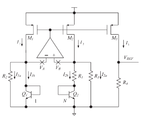cr4zypt
Newbie level 4

- Joined
- Feb 25, 2015
- Messages
- 5
- Helped
- 0
- Reputation
- 0
- Reaction score
- 0
- Trophy points
- 1
- Activity points
- 48
Hello guys,
So I began working on my thesis couple days ago and I encountered some existential doubts I never realized I had.
Take into account this circuit, which a standard sub-1v base-emitter voltage based bandgap.

Now, i've done the math for the resistor and current values, assuming an ideal opamp.
Assume a standard 0.13um CMOS process that gives us CTAT 1.73mv/C and PTAT = 0.09 mv/C
CTAT/PTAT = 19.2 I chose 1:8 bjt ratio meaning R3/R1 = 9.24
I chose a Q1 - Q2 ratio of 1:8 so that gives us 0.0541 V around R1 (delta VBe = VT*ln(8))
For a 6uA current on that branch that would gives us an R1 ~9k
With R3/R1 ratio it gives us R3 = 83k.
Meaning the current over R3 = Va (Vbe) = Vb = ~0.7/83k = 8.4uA.
So, looking at the picture we have I2a = 8.4uA, I2b=6uA. This gives I2 = 8.4+6 = 14.4uA.
Now the questions.
If we assume 30ºC that gives Vbe of around 0.7 = Va = Vb. At this point what value do we expect at opamp output (mosfet gates)?
If the gates are driven by the opamp then I should scale their W/L so that the current I1 = I2 equals that value calculated before (14.4uA) right?
Thanks,
So I began working on my thesis couple days ago and I encountered some existential doubts I never realized I had.
Take into account this circuit, which a standard sub-1v base-emitter voltage based bandgap.

Now, i've done the math for the resistor and current values, assuming an ideal opamp.
Assume a standard 0.13um CMOS process that gives us CTAT 1.73mv/C and PTAT = 0.09 mv/C
CTAT/PTAT = 19.2 I chose 1:8 bjt ratio meaning R3/R1 = 9.24
I chose a Q1 - Q2 ratio of 1:8 so that gives us 0.0541 V around R1 (delta VBe = VT*ln(8))
For a 6uA current on that branch that would gives us an R1 ~9k
With R3/R1 ratio it gives us R3 = 83k.
Meaning the current over R3 = Va (Vbe) = Vb = ~0.7/83k = 8.4uA.
So, looking at the picture we have I2a = 8.4uA, I2b=6uA. This gives I2 = 8.4+6 = 14.4uA.
Now the questions.
If we assume 30ºC that gives Vbe of around 0.7 = Va = Vb. At this point what value do we expect at opamp output (mosfet gates)?
If the gates are driven by the opamp then I should scale their W/L so that the current I1 = I2 equals that value calculated before (14.4uA) right?
Thanks,

